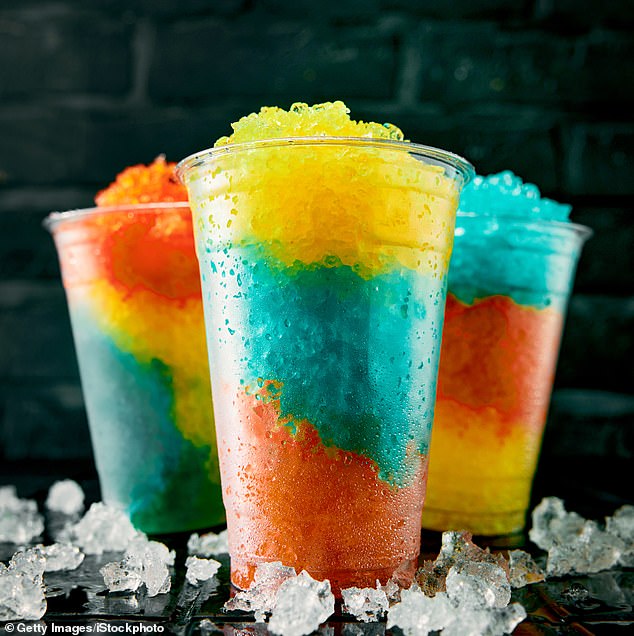How dangerous are slushies for children? Scientists reveal why some children are hospitalized after drinking one – and who could be at risk
It was a story as baffling as it was shocking. Last week, a four-year-old child became the second child this year to be hospitalized after consuming a slushy.
The brightly colored iced drinks are sold in convenience stores, cinemas and fairs – and are seen as a favorite sweet treat for the whole family.
Albie Green, from Warwickshire, reportedly became seriously unwell – ‘hallucinating’ and ‘clawing his face’ – after drinking a small strawberry-flavoured slushy at an after-school bowling party.
It was suggested that his illness was an adverse reaction to glycerol, the artificial sweetener used in the drinks that keeps them from freezing solid.
Although Albie has recovered, many parents understandably wonder if their children are in danger.
Now The Mail can reveal that scientists are investigating an intriguing theory: that some children carry a genetic mutation that makes glycerol poisonous to them.
In July 2023, a major supplier of slushies, British company Nichols, which produces two of the most popular brands, Slush Puppie and Starlush, removed the sweetener from its products as a precaution for child safety, we have learned.
Beth Green faced a parent’s worst nightmare when her four-year-old son Albie became unresponsive after drinking a small strawberry-flavored slushy.
However, glycerol is still present in most slushies available on the UK high street and is used in a wide variety of confectionery and cereal bars.
Experts are now calling on local health authorities to warn parents about the dangers of slushies, which contain a large amount of glycerol, to prevent further hospital admissions and even possible deaths.
In addition to glycerol, or E422, slushies typically contain citric acid as a preservative, artificial fruit flavor, food coloring, salt and water.
But experts agree that glycerol is most likely responsible for two recent cases of child unwellness – and last year the government’s Food Standards Agency advised retailers not to sell slushies to children under four, and not to offer free refills to to children under 10 years old.
It came after two previous cases in 2021 and 2022 of children in Scotland being hospitalized after drinking slushies.
So how concerned should parents be?

Beth, 24, from Nuneaton, Warwickshire, feared Albie would die unconscious an hour after drinking the ice-cold drink
In addition to its use as a sugar substitute, glycerol is used in medical treatments – it is used to tackle eye diseases glaucoma and relieve constipation.
Experts believe that glycerol in food and drinks is essentially harmless to adults.
Jaffa Cakes, Angel Slices and Cherry Bakewells all contain small amounts of glycerol – which is also listed in the ingredients as glycerine – to ensure the outside of these treats stay moist and soft.
Cereal bars such as Nature Valley and Alps – which are often promoted as a natural alternative to sweet treats – also contain glycerol for the same purpose.
The majority of these foods appear to contain very small traces of glycerol, but companies are not required to declare how much is in their products.
However, the additive has become increasingly common in drinks since 2018, when the government introduced the sugar tax on soft drinks.
The tax is estimated to have saved thousands of children from tooth extractions, as sugar is one of the leading causes of tooth decay in children.
However, the concentration of glycerol currently in soft drinks such as slushies can be dangerous for some younger children.
Last month, three-year-old Angus Anderson was taken to hospital when he unexpectedly collapsed 30 minutes after drinking a raspberry-flavoured slushy he bought at a local corner shop.
His mother, 29-year-old Victoria from Inverclyde, Scotland, described how Angus’ eyes rolled into the back of his head and his body became ‘stone cold’.
Angus was the third child in Scotland to be hospitalized after drinking a slushy, where the drink appears to be particularly popular.
In 2022, supermarket SPAR Scotland announced a partnership with frozen dessert brand Calippo to install glycerol-containing slushy machines in all of its 320 stores across the country.
Mrs Anderson, who has since called for a ban on slushies, was told by doctors at Glasgow Children’s Hospital that her son had suffered glycerol poisoning, where overconsumption of glycerol can cause headaches, nausea and loss of consciousness.
However, why this condition occurs is debated among experts.

In August 2023, the Food Standards Agency said that slushies could be dangerous to children under four in rare circumstances. Just one 350ml drink can tip them over the safe threshold
One argument is that glycerol dehydrates children and lowers their blood sugar levels.
‘Glycerol is very effective at absorbing excess water in the body, which is why it is used to treat glaucoma, which is caused by a build-up of fluid in the eye,’ says Professor James Caulson, a toxicology expert at the University of Cardiff.
‘This water is then removed from the body with the glycerol. However, glycerol can sometimes also absorb a lot of sugar from the bloodstream during this process.
“That sudden loss of water can give people headaches, and the loss of sugar can have a significant effect on the body.”
Prof Caulson says children who consume a large amount of glycerol can suffer from hypoglycaemia – a low blood sugar level that usually accompanies diabetes and leads to tremors, dizziness and even seizures.
He added: ‘So it is no surprise that small children can become unwell if they consume a lot of glycerol.’
Worryingly, experts also say that slushies can vary significantly in glycerol content depending on where they are sold.
According to the Food Standards Agency, most slushies contain around 16 grams – or about four teaspoons – of glycerol.
However, there is no maximum amount of glycerol that manufacturers must legally adhere to. Most brands also don’t mention how much glycerol is in each slushy.
‘These products can vary widely in the amount of glycerol that goes into them,’ says Professor Caulson.
‘There have been reports in the past of manufacturing defects resulting in similar products containing much more glycerol than expected, resulting in children ending up in hospital.’
But other experts say this theory does not explain why only some children have become seriously ill from products consumed by thousands of young people every day.
‘Many children drink slushies, but these terrible side effects appear to be quite rare,’ says Prof Alan Boobis, a toxicology expert at Imperial College London and government adviser.
Instead, Prof. Boobis says it’s possible that the children who had severe reactions after drinking slushies could have a rare genetic condition, which means their bodies can’t process glycerol.
For example, some children are born with a condition called fructose-1,6-bisphosphatase deficiency, which means they cannot produce enough of a certain enzyme that the body uses to break down glycerol and convert it to glucose – or sugar.
The rare condition can occur at any time in life and, depending on its severity, can lead to a range of symptoms, including drowsiness, hypoglycemia and seizures.
Many people may never realize they have the problem.
Prof Boobis believes that a small child with this condition can become seriously ill if he consumes a large portion of glycerol.
“In this situation, consuming a lot of glycerol can overwhelm the body and cause a health crisis,” he says.
‘Because the body cannot process the glycerol, this can block the production of all the glucose in the body, causing the child to have severe hypoglycaemia.’
Prof Boobis insists his assessment is currently just a theory and wants more research to be done to see if this explains the rise in slushy-related hospital admissions, especially in Scotland.
“It is possible that all those affected share the same genes or are related in some way,” he says.
If he is right, given the rarity of this genetic condition, a significant increase in reports of children exhibiting severe reactions to slushies is unlikely.
However, he warns that the majority of children with the condition would be undiagnosed, meaning there is no way for parents to know whether their children are at risk or not.
“Banning slushies would be an extreme measure, because you would be depriving thousands of people of something that is safe and enjoyable for them, in order to protect a small handful of children who are at risk,” says Prof. Boobis.
‘However, it should be the responsibility of local health authorities to warn parents about the risks of the drinks.
‘If (the side effects) are caused by a genetic condition, you are unlikely to know your child is at risk until he becomes ill.’
